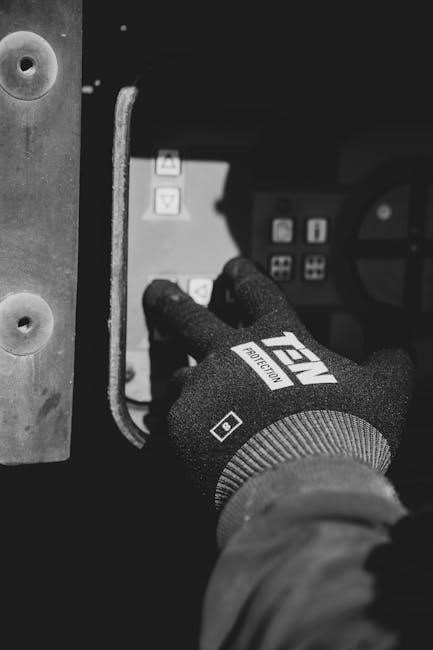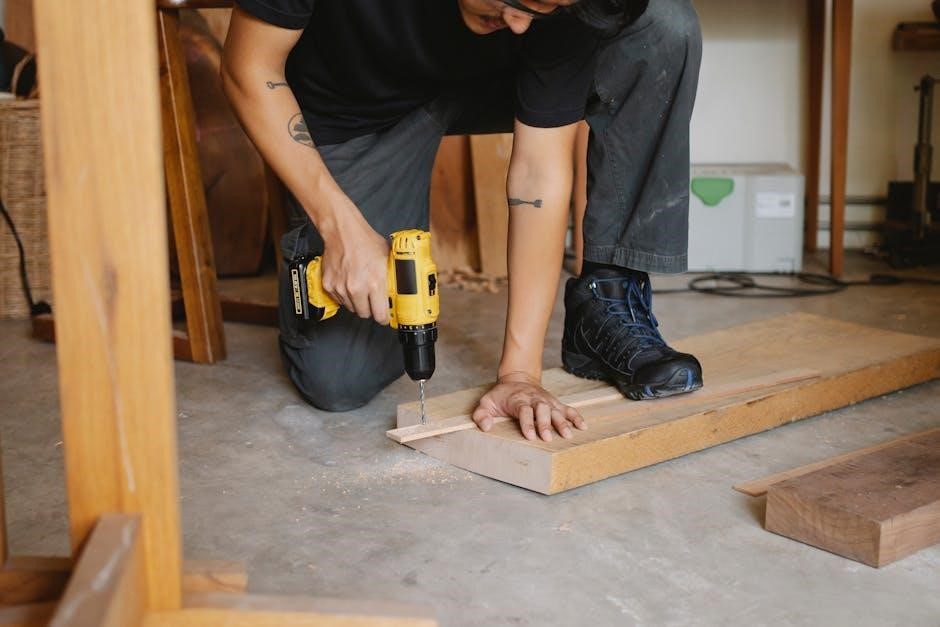The neutral safety switch is a critical component in manual transmission vehicles‚ ensuring the engine starts only in neutral gear. It prevents accidental starting in gear‚ enhancing safety and control.
1.1 Definition and Purpose
The neutral safety switch is an essential electrical component in manual transmission vehicles. It is designed to control the engine’s starting function‚ ensuring the vehicle only starts when the transmission is in neutral gear. This prevents accidental engine ignition while the car is in gear‚ which could lead to unintended movement. By monitoring the transmission’s gear position‚ the switch acts as a safety mechanism‚ enhancing overall vehicle control and driver safety; Its primary role is to protect the vehicle and driver from potential hazards associated with improper starting conditions.
1.2 Importance in Manual Transmission Vehicles
The neutral safety switch plays a vital role in manual transmission vehicles by preventing accidental engine starting in gear. This avoids unintended vehicle movement‚ reducing the risk of accidents and damage. It ensures smooth operation by allowing the engine to start only when the transmission is in neutral‚ providing a safety net for drivers. Additionally‚ it helps protect the transmission and starter motor from potential strain caused by improper starting conditions‚ making it an indispensable component for safe and reliable vehicle operation.

Location and Installation of the Neutral Safety Switch
The neutral safety switch is typically mounted on the manual transmission‚ connected to the gearshift mechanism. It is linked to both mechanical and electrical systems‚ ensuring proper functionality.
2.1 Typical Placement on Manual Transmissions
The neutral safety switch is commonly mounted on the side or top of the manual transmission case‚ near the gearshift linkage. It is mechanically linked to the gearshift mechanism to monitor the transmission’s gear position. This strategic placement allows the switch to accurately detect when the vehicle is in neutral‚ ensuring the ignition system only engages in this position. The switch is typically bolted to the transmission housing and connected via wiring to the vehicle’s electrical system‚ making it an integral part of the transmission and ignition control setup.
2.2 Connection to the Transmission and Ignition System
The neutral safety switch is typically connected to the transmission via a mechanical linkage that monitors the gearshift’s position. This linkage ensures the switch activates only when the vehicle is in neutral. Electrically‚ the switch is wired into the ignition circuit‚ often through the ignition coil or starter motor‚ allowing the engine to start only in neutral. Modern vehicles may integrate the switch with an ECU for centralized control‚ enhancing safety and system coordination. This setup prevents accidental starting in gear‚ ensuring safe and reliable vehicle operation.

Working Mechanism of the Neutral Safety Switch
The neutral safety switch operates by engaging mechanically with the transmission’s gear selector. When in neutral‚ it completes the ignition circuit‚ allowing the engine to start safely.
3.1 Mechanical Linkage and Electrical Circuit
The neutral safety switch relies on a mechanical linkage connected to the manual transmission’s gear selector; This linkage moves when the transmission is shifted into neutral‚ activating the switch. The electrical circuit is designed to allow the starter motor to function only when the switch is engaged‚ ensuring the engine starts safely. The switch acts as a critical connector between the transmission’s mechanical state and the vehicle’s ignition system‚ preventing accidental starting in gear by interrupting the circuit when not in neutral.
3.2 Role in Preventing Accidental Starting
The neutral safety switch plays a crucial role in preventing accidental starting of the engine when the transmission is in gear. By ensuring the starter motor only activates when the vehicle is in neutral‚ it avoids unintended movement of the car. This safety mechanism is vital for manual transmissions‚ as starting in gear could lead to sudden acceleration‚ posing risks to both the driver and bystanders. The switch acts as a safeguard‚ enhancing overall vehicle safety and preventing potential accidents caused by improper starting conditions.

Common Symptoms of a Faulty Neutral Safety Switch
- Car fails to start in neutral gear.
- Engine starts while in gear‚ risking sudden movement.
- Intermittent starting issues occur unexpectedly.
- Transmission struggles to engage or disengage properly.
4.1 Car Does Not Start in Neutral
A common symptom of a faulty neutral safety switch is when the car fails to start while in neutral gear. This occurs because the switch prevents the ignition circuit from engaging unless the transmission is in neutral. If the switch is malfunctioning‚ it may not send the proper signal‚ causing the engine to not start. This issue can be frustrating‚ especially in manual transmissions‚ where starting in neutral is essential. Checking the switch’s electrical connections and mechanical linkage is crucial to resolve this problem. If faulty‚ replacement is typically necessary to restore normal function.
4.2 Car Starts in Gear
A faulty neutral safety switch can cause the car to start while in gear‚ bypassing the safety mechanism designed to prevent this. This occurs when the switch fails to block the ignition circuit properly‚ allowing the engine to start even when the transmission is not in neutral. This situation is dangerous‚ as the vehicle may unexpectedly move‚ leading to accidents or injuries. Immediate attention is required to repair or replace the switch to restore safety and proper functionality to the ignition system.
4.3 Intermittent Starting Issues
One common symptom of a faulty neutral safety switch is intermittent starting problems. This occurs when the switch inconsistently engages‚ preventing the car from starting reliably; The issue may stem from worn mechanical components or electrical connections within the switch‚ leading to sporadic activation of the ignition circuit. Improper adjustment or corrosion can also cause erratic behavior‚ making it difficult to diagnose. Addressing this issue promptly is crucial to avoid being stranded and ensure consistent vehicle operation.
4.4 Transmission Engagement Problems
A faulty neutral safety switch can lead to transmission engagement issues‚ such as difficulty shifting into gear or delayed engagement. This occurs when the switch fails to send proper signals to the transmission control module‚ disrupting smooth operation. Misalignment or wear in the mechanical linkage can exacerbate the problem‚ causing inconsistent or incorrect gear engagement. Electrical malfunctions may also result in erratic transmission behavior‚ such as slipping or hesitation; Addressing these issues promptly is essential to maintain proper transmission function and prevent further damage to the system.

Causes of Neutral Safety Switch Failure
Failure often results from wear and tear‚ improper adjustment‚ or electrical circuit malfunctions. These issues disrupt the switch’s ability to function correctly.
5.1 Wear and Tear Over Time
Wear and tear is a primary cause of neutral safety switch failure. Over time‚ the mechanical components of the switch can degrade due to repeated use and friction. The internal contacts and bushings may wear out‚ leading to inconsistent or faulty electrical connections. This wear can result in intermittent or complete loss of the switch’s ability to signal the powertrain control module (PCM) when the transmission is in neutral. Regular use and exposure to heat and vibration exacerbate this deterioration‚ making the switch prone to failure over the vehicle’s lifespan.
5.2 Improper Adjustment
Improper adjustment of the neutral safety switch is another common cause of failure. If the switch is not aligned or calibrated correctly with the gearshift or transmission‚ it may fail to engage properly. This misalignment can prevent the switch from signaling the PCM accurately‚ leading to issues like difficulty starting the car or the engine not cranking in neutral. Improper adjustment often occurs during installation or repair‚ emphasizing the importance of precise calibration to ensure proper function and reliability of the switch over time.
5.3 Electrical Circuit Malfunction
An electrical circuit malfunction can disrupt the neutral safety switch’s operation. This may occur due to faulty wiring‚ corroded connectors‚ or a blown fuse in the circuit. Such issues can prevent the switch from sending the correct signal to the vehicle’s computer‚ leading to problems like the car not starting in neutral or starting in gear. Intermittent electrical faults can cause unpredictable behavior‚ making diagnosis challenging. Addressing these issues often requires inspecting and repairing the wiring and connections to ensure proper communication between the switch and the vehicle’s systems.

Diagnosing a Faulty Neutral Safety Switch
Diagnosing a faulty neutral safety switch involves checking its electrical and mechanical functions. Start by testing the switch with a multimeter to ensure proper continuity. Bypassing the switch temporarily can help confirm if it’s the source of the issue. Inspect the wiring and connections for any damage or corrosion. Additionally‚ check the mechanical linkage connected to the transmission to ensure it’s accurately indicating neutral. If symptoms persist‚ consulting a professional may be necessary for precise diagnosis and repair.
6.1 Testing the Switch with a Multimeter
To test the neutral safety switch with a multimeter‚ first locate the switch‚ typically near the transmission. Set your multimeter to measure continuity or resistance. Identify the input and output terminals using a wiring diagram specific to your vehicle. With the car in neutral and the parking brake applied‚ probe the terminals to check for continuity. The switch should show continuity in neutral and no continuity in gear. If readings are inconsistent‚ the switch may be faulty. Always ensure safety by disconnecting the battery before starting the test.
6.2 Bypassing the Switch for Diagnostic Purposes
Bypassing the neutral safety switch involves temporarily connecting the battery directly to the ignition system to test if the car starts without the switch. Disconnect the battery to prevent accidental starting. Locate the switch’s wiring harness and identify the correct terminals using a wiring diagram. Use a jumper wire to connect the battery positive terminal to the ignition input terminal. Attempt to start the car to determine if the issue lies with the switch. Exercise caution‚ as bypassing can pose safety risks. Always reconnect the battery properly after testing.

Replacement and Repair of the Neutral Safety Switch
Replacing the neutral safety switch involves identifying the issue‚ purchasing the correct part‚ and following step-by-step instructions. Consult a repair manual for specific guidance and tools needed.
7.1 Tools and Materials Needed
To replace the neutral safety switch‚ you’ll need a set of screwdrivers (flathead and Phillips)‚ a wrench or socket set‚ a jack‚ and jack stands for safety. Pliers‚ a multimeter‚ and dielectric grease are also essential for handling electrical connections. Specialized tools may be required for specific connectors. Materials include a new neutral safety switch‚ screws or bolts‚ wire connectors‚ and cleaning supplies. A torque wrench and flashlight are recommended‚ along with gloves and safety glasses. Consult a repair manual for specific guidance and tools needed for your vehicle.
7.2 Step-by-Step Replacement Process
Begin by lifting the vehicle and disconnecting the battery. Locate the neutral safety switch‚ typically mounted on the transmission. Disconnect the electrical connector and remove the mounting bolts. Gently pull off the switch from its bracket. Install the new switch‚ ensuring proper alignment and secure it with bolts. Reconnect the electrical connector and reconnect the battery. Test the switch by starting the engine in neutral and attempting to shift into gear. Verify proper function and tighten all connections. Finally‚ lower the vehicle and test drive to ensure everything operates smoothly.
7.3 Post-Replacement Testing
After installing the new neutral safety switch‚ perform a series of tests to ensure proper function. Start by turning the ignition to the “on” position and shifting through all gears‚ including neutral. Verify the vehicle starts only in neutral and not in any gear. Check for any unusual noises or resistance during gear shifts. Test the transmission’s engagement and disengagement smoothly. Finally‚ take the vehicle for a test drive to confirm smooth operation and proper shifting. If issues persist‚ consult a professional mechanic for further assistance.

Preventive Maintenance Tips
Regular inspection and proper adjustment of the neutral safety switch can prevent premature wear. Avoiding rough shifting and ensuring clean connections also help maintain its functionality.
8.1 Regular Inspection
Regular inspection of the neutral safety switch ensures optimal performance. Check the switch’s mounting for tightness and inspect for wear or corrosion. Verify electrical connections are clean and secure. Test the switch’s operation by shifting through gears‚ ensuring it engages smoothly in neutral. If resistance or erratic behavior is detected‚ address it promptly. Schedule inspections every 6-12 months or when experiencing starting issues. Early detection of problems prevents costly repairs and maintains safety. Use a multimeter to test electrical continuity if unsure. Consistent checks help extend the switch’s lifespan and reliability.
8.2 Avoiding Rough Driving Habits
Avoiding rough driving habits is crucial for maintaining the neutral safety switch’s longevity. Abrupt shifting‚ riding the clutch‚ or sudden acceleration can stress the switch’s mechanical components. Smooth gear transitions and avoiding excessive force on the gearshift reduce wear. Refrain from resting your hand on the gearshift‚ as this can cause unintended pressure on the switch. By driving gently and intentionally‚ you minimize the risk of premature failure. Consistent smooth operation preserves the switch’s functionality and ensures reliable performance over time. Rough habits can lead to costly repairs‚ so mindful driving is essential.

Common Mistakes During Replacement
Common mistakes include incorrect adjustment‚ using the wrong replacement switch‚ or improper wiring connections. These errors can lead to poor transmission performance or safety hazards.
9.1 Incorrect Adjustment
Incorrect adjustment of the neutral safety switch is a common mistake during replacement. If the switch is not properly aligned or tightened‚ it can disrupt the electrical connection and mechanical linkage. This may cause issues like the car not starting in neutral or starting in gear; Ensuring the switch is adjusted according to the manufacturer’s specifications is crucial. Improper alignment can lead to premature wear or failure of the switch. Always refer to the vehicle’s manual for correct adjustment procedures to avoid such problems and maintain proper transmission function.
9.2 Using the Wrong Replacement Switch
Using the wrong replacement switch can lead to mechanical and electrical compatibility issues. A mismatched switch may not align properly with the transmission or ignition system‚ causing starting problems or unintended gear engagement. Always ensure the replacement switch is compatible with the vehicle’s make‚ model‚ and transmission type. Refer to the manufacturer’s specifications to avoid installation errors. Using a non-original or incorrect switch can result in poor performance and safety hazards‚ such as the car starting in gear or failing to start altogether.

Cost Implications
The cost of replacing a neutral safety switch varies based on the vehicle make‚ model‚ and labor rates. Parts typically range between $50 to $200‚ while labor costs can add another $100 to $300‚ depending on the workshop. Additional fees may apply if other components need repair or adjustment during the replacement process.
10.1 Parts and Labor Costs
The cost of a neutral safety switch replacement includes both parts and labor. The switch itself typically ranges from $50 to $200‚ depending on the vehicle’s make and model. Labor costs can vary between $100 to $300‚ with higher rates at dealerships compared to independent shops. Additional fees may apply if the transmission or electrical system requires adjustments. Overall‚ the total cost usually falls between $200 to $500‚ making it a relatively affordable repair compared to other transmission-related issues. Factors like location and workshop rates can influence the final price.
10.2 Factors Affecting Total Cost
The total cost of a neutral safety switch replacement can vary based on several factors. The vehicle’s make‚ model‚ and year play a significant role‚ as luxury or high-performance vehicles often require more expensive parts. Labor rates differ between dealerships and independent shops‚ with dealers typically charging more. Location also impacts pricing‚ as urban areas tend to have higher labor costs. Additional repairs‚ such as transmission adjustments or electrical work‚ can increase the total expense. Lastly‚ using OEM versus aftermarket parts affects the final cost‚ with OEM parts generally being more expensive.
The neutral safety switch is vital for manual transmissions‚ ensuring safety and function. Regular inspections and timely replacements prevent issues‚ ensuring reliability and safety.
11.1 Summary of Key Points
The neutral safety switch is a critical component in manual transmissions‚ ensuring the vehicle starts only in neutral and preventing accidental engagement. It is typically located on the transmission and connected to the ignition system. Over time‚ wear‚ improper adjustment‚ or electrical issues can cause failure‚ leading to symptoms like starting problems or transmission engagement issues. Regular inspections‚ proper adjustments‚ and avoiding rough driving habits help maintain its functionality. Replacing the switch requires careful steps and the right tools to ensure safety and reliability.
11.2 Final Thoughts on Maintenance and Safety
Regular maintenance of the neutral safety switch is crucial for ensuring vehicle safety and reliability. Proper adjustment and avoiding rough driving habits can significantly extend its lifespan. Promptly addressing any issues prevents accidental starts and potential accidents. Neglecting this component can lead to serious safety hazards. Always prioritize the integrity of the neutral safety switch to maintain smooth operation and protect against dangers on the road. A well-maintained switch ensures a safer and more efficient driving experience.